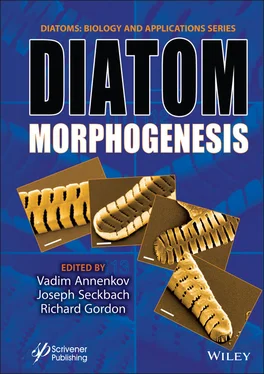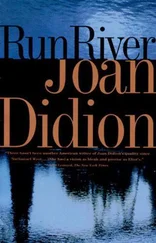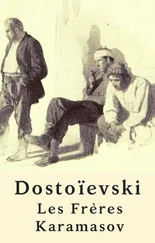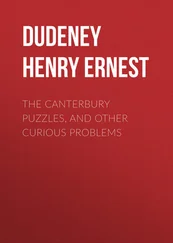Diatom Morphogenesis
Здесь есть возможность читать онлайн «Diatom Morphogenesis» — ознакомительный отрывок электронной книги совершенно бесплатно, а после прочтения отрывка купить полную версию. В некоторых случаях можно слушать аудио, скачать через торрент в формате fb2 и присутствует краткое содержание. Жанр: unrecognised, на английском языке. Описание произведения, (предисловие) а так же отзывы посетителей доступны на портале библиотеки ЛибКат.
- Название:Diatom Morphogenesis
- Автор:
- Жанр:
- Год:неизвестен
- ISBN:нет данных
- Рейтинг книги:5 / 5. Голосов: 1
-
Избранное:Добавить в избранное
- Отзывы:
-
Ваша оценка:
- 100
- 1
- 2
- 3
- 4
- 5
Diatom Morphogenesis: краткое содержание, описание и аннотация
Предлагаем к чтению аннотацию, описание, краткое содержание или предисловие (зависит от того, что написал сам автор книги «Diatom Morphogenesis»). Если вы не нашли необходимую информацию о книге — напишите в комментариях, мы постараемся отыскать её.
A unique book presenting the range of silica structures formed by diatoms, theories and hypotheses of how they are made, and applications to nanotechnology by use or imitation of diatom morphogenesis.
Audience
Diatom Morphogenesis — читать онлайн ознакомительный отрывок
Ниже представлен текст книги, разбитый по страницам. Система сохранения места последней прочитанной страницы, позволяет с удобством читать онлайн бесплатно книгу «Diatom Morphogenesis», без необходимости каждый раз заново искать на чём Вы остановились. Поставьте закладку, и сможете в любой момент перейти на страницу, на которой закончили чтение.
Интервал:
Закладка:
We have proposed that diatoms possess “uncanny symmetry” [2.134]. By uncanny symmetry is meant that (some) diatoms in valve view (may) exhibit near perfect symmetry. It was shown that by subtracting the rotated image of a given diatom from its original image, an almost completely blacked out image would result, indicating near perfect matching of image pixels, suggesting near perfect symmetry [2.134]. Such results were obtained for Aulacodiscus oregonus and Triceratium formosum var. quinquelobata (Plate 7, Figures 1–4 in [2.134]). “The apparently high degree of perfection of this noncrystalline precipitate deserves quantification, which may prove comparable with the (small) degree of imperfection of crystalline snowflakes [2.83]” [2.134].
Centric diatoms exhibit rotational symmetry in shape and surface, but other symmetries such as dihedral symmetry are present as well. A case in point is Auliscus (Plate 5, Figure 1 in [2.134]). From dihedral symmetry, reflective symmetry of this diatom may be characterized as a 180° rotational symmetry, thereby identifying rotational symmetry as a starting point in the measurement of uncanny symmetry. That multiple symmetries occur simultaneously in centric diatom may be recovered by an uncanny symmetry measurement.
As suggested in [2.134], we propose to quantify centric diatom symmetry generally and uncanny symmetry specifically using concepts from information theory and image processing methods. Because symmetry involves the acquisition of information regarding the “balance” of an organism such as a diatom, information theory is used to develop a measure of centric diatom valve uncanny symmetry.
The incongruity of diatom morphogenesis and uncanny symmetry can be summarized in the question, why should diatoms possess uncanny symmetry? Symmetry is about pattern, and morphogenesis is about process. Why should this specific process produce a near perfect valve pattern and shape in diatoms? We propose to address this question by quantifying uncanny symmetry, quantifying the relation of uncanny symmetry to stability, and analyzing these results to determine the implications that symmetry via stability has on the diatom morphogenetic process.
2.1.5 Purpose of This Study
This study was conducted to measure rotational symmetry in centric diatoms and relate changes in symmetry to instability in a diatom morphogenetic dynamical system. We will demonstrate that symmetry is measurable explicitly as a deterministic quantity, and instability may be parsed to quantify deterministic and non-deterministic behavior in a morphogenetic dynamical system. Information contained in valve morphology is measurable via entropy, and this information is related to symmetry. Uncanny symmetry may be measured at multiple scales, and entropy as the measurement of this information is related to morphogenesis. Quantified centric diatom uncanny symmetry will be used to characterize behavior of symmetry changes for a variety of taxa. The relationship of uncanny symmetry to stability changes during centric diatom valve formation will be quantified using concepts from dynamical systems analysis. From here on out, we use the term symmetry to mean uncanny symmetry.
2.2 Methods
2.2.1 Centric Diatom Images Used for Analysis
Taxa were selected from a catalog of scanning electron micrographs (SEMs) in the library of one of the authors (M.A.T.). SEMs of centric diatom genera represented by selected species were used to quantify and analyze uncanny symmetry of diatom valve shape. Taxa selected for use represented circular, eccentric, and polygonal valve shapes that span the range of shapes of centric diatoms. A number of criteria were used to select images for analysis. Images were taken so that the view was determined to be perpendicular to the valve, where the valve appeared to be flat or at 0°. The whole valve had to be unbroken or in a state where breakage was qualitatively deemed to not impair the ability to discern the surface and/or shape boundary. The entire valve outline was unobstructed by debris, or if debris was present, it was qualitatively deemed to not detract from discerning the surface and/or shape boundary. Individuals were chosen to represent closely related species, and multiple species were selected from each genus when feasible.
Taxa whose images were chosen for study are given in Table 2.1. These 15 centric diatom genera represent a wide variety of genera, species, shapes, and valve patterns found in centric diatoms. Within each genus, species exhibit distinct features that are associated with the silica deposition process as evidenced by the morphology on the valve face. Morphological valve features are a record of silica deposition during valve formation and part of the morphogenetic process. The shape and position of valve features are indicators of symmetry of the valve surface.
Table 2.1 List of species considered and thumbnail, masked image examples for all of the individual diatom taxa we analyzed, all scaled to the same apparent diameter, along with individual number of rotations. Actual diameters vary with the life cycle. All thumbnails are external valves. All SEMs by Mary Ann Tiffany.
| Genus species | Thumbnail images | Rotations |
|---|---|---|
| 1. Actinoptychus | ||
| 1.1. Actinoptychus senarius |  |
3 |
| 1.2. Actinoptychus splendens |  |
14 |
| 2. Amphitetras antediluviana |  |
4 |
| 3. Arachnoidiscus | ||
| 3.1. Arachnoidiscus ehrenbergii |  |
14-31 |
| 3.2. Arachnoidiscus ornatus |  |
17-24 |
| 4. Asterolampra | ||
| 4.1. Asterolampra grevillei |  |
13 |
| 4.2. Asterolampra marylandica |  |
7 |
| 5. Asteromphalus | ||
| 5.1. Asteromphalus heptactis |  |
7 |
| 5.2. Asteromphalus imbricatus |  |
9 |
| 5.3. Asteromphalus shadboltianus |  |
7 |
| 5.4. Asteromphalus vanheurckii |  |
10-11 |
| 6. Aulacodiscus | ||
| 6.1. Aulacodiscus africanus |  |
4-5 |
| 6.2. Aulacodiscus kittonii |  |
4 |
| 6.3. Aulacodiscus oregonus |  |
8-13 |
| 6.4. Aulacodiscus petersii |  |
3 |
| 6.5. Aulacodiscus rogersii |  |
3 |
| 6.6. Aulacodiscus scaber |  |
3 |
| 7. Coscinodiscus sp. |  |
14 |
| 8. Cyclotella meneghiniana |  |
3-64 |
| 9. Eupodiscus radiatus |  |
4 |
| 10. Glyphodiscus stellatus |  |
4 |
| 11. Lampriscus shadboltianum |  |
3 |
| 12. Spatangidium arachne |  |
5 |
| 13. Triceratium bicorne |  |
4 |
| 14. Triceratium | ||
| 14.1. Triceratium castellatum var. fractum |  |
3 |
| 14.2. Triceratium crenulatum |  |
3 |
| 14.3. Triceratium favus |  |
3 |
| 14.4. Triceratium favus var. maxima |  |
3 |
| 14.5. Triceratium favus var. quadrata |  |
3 |
| 14.6. Triceratium impressum |  |
3 |
| 14.7. Triceratium pentacrinus fo. quadrata |  |
4 |
| 14.8. Triceratium sp. [fossils] |  |
4-15 |
| 15. Trigonium | ||
| 15.1. Trigonium alternans |  |
3 |
| 15.2. Trigonium arcticum |  |
3 |
| 15.3. Trigonium arcticum var. kerguelense |  |
3 |
| 15.4. Trigonium arcticum var. quadrata |  |
4 |
| 15.5. Trigonium dubium |  |
3 |
| 15.6. Trigonium formosum fo. quadrata |  |
4 |
Aulacodiscus species can be differentiated by their tube openings, not only in the number on the valve face near the margin but also in terms of the shape and whether the tubes have external flanges or distinct internal structures. Tube openings are positioned on the valve and are indicative of symmetry. Tube opening formation occurs as valve formation proceeds. Externally flanged with tongued and ridged internal tube structures are present in circular tubed A. scaber and A. petersii in contrast to A. africanus and A. kittonii with slitted tube openings with no distinct internal structures. The fossil species, Aulacodiscus rogersii , has a flanged circular tube opening as does A. oregonus . Tube openings are formed near the valve margin, and their number and position on the valve margin are indicators of valve formation [2.144].
Читать дальшеИнтервал:
Закладка:
Похожие книги на «Diatom Morphogenesis»
Представляем Вашему вниманию похожие книги на «Diatom Morphogenesis» списком для выбора. Мы отобрали схожую по названию и смыслу литературу в надежде предоставить читателям больше вариантов отыскать новые, интересные, ещё непрочитанные произведения.
Обсуждение, отзывы о книге «Diatom Morphogenesis» и просто собственные мнения читателей. Оставьте ваши комментарии, напишите, что Вы думаете о произведении, его смысле или главных героях. Укажите что конкретно понравилось, а что нет, и почему Вы так считаете.












